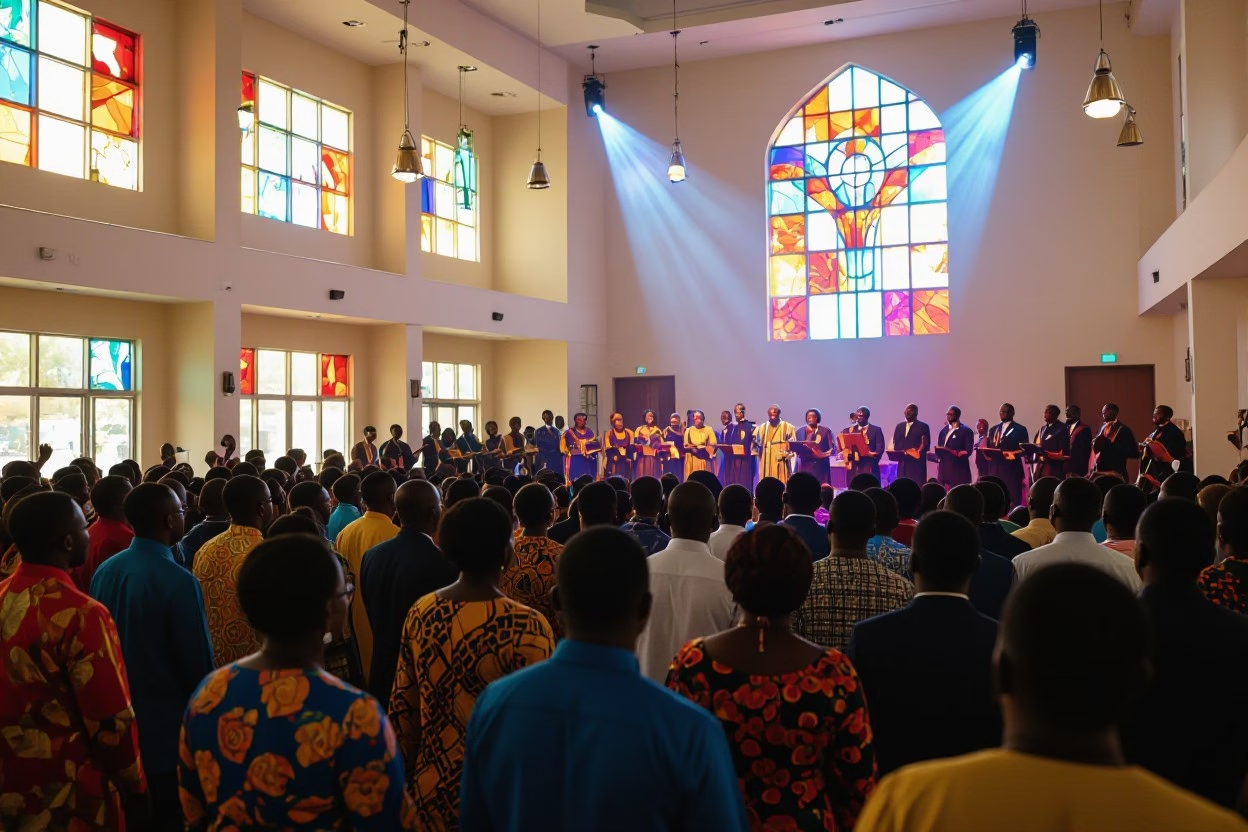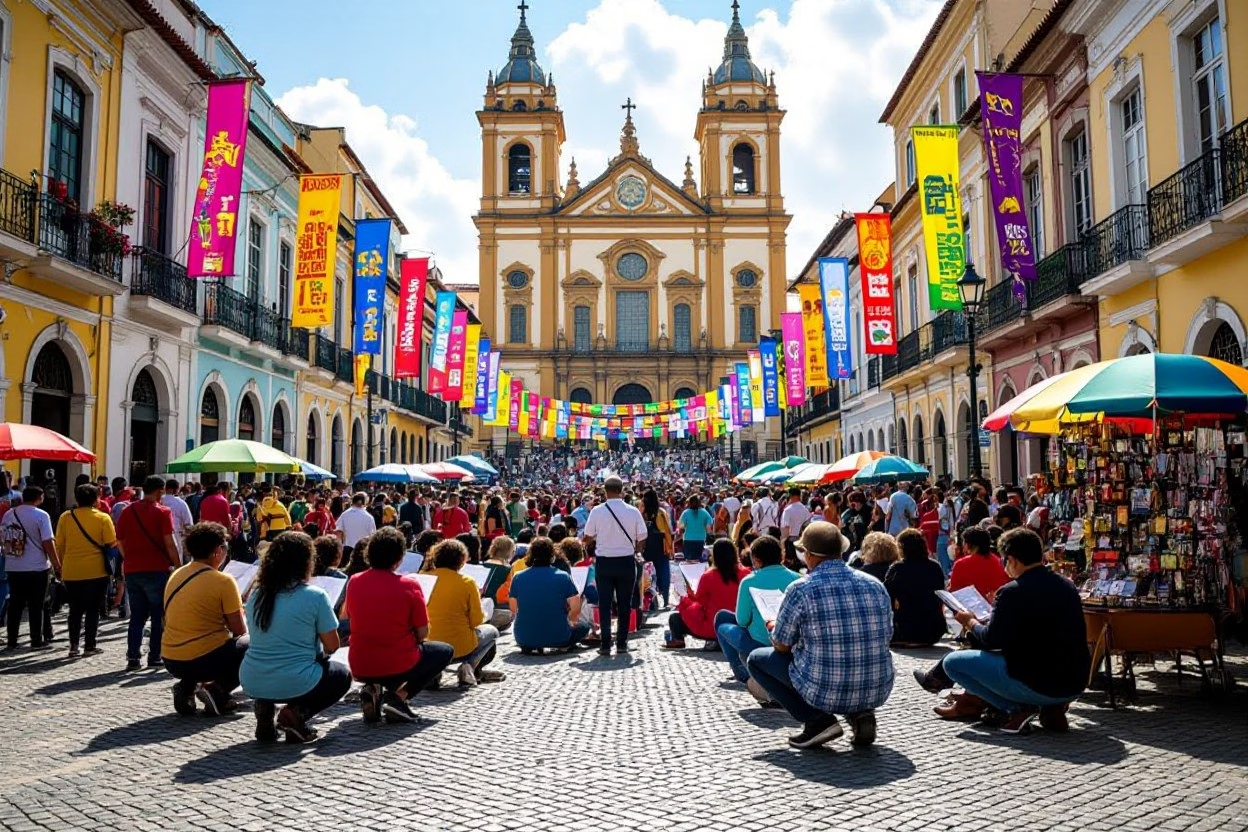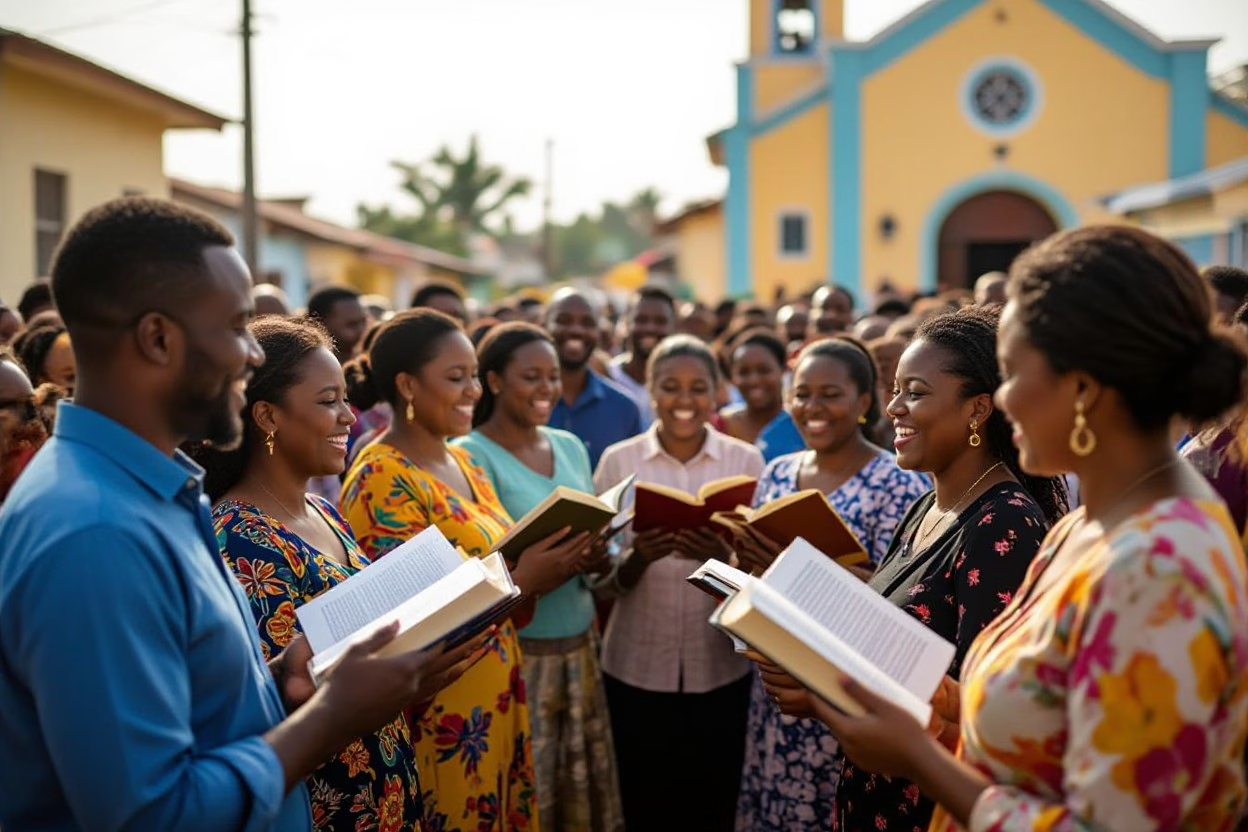It’s important for you to understand where Christianity is expanding most swiftly around the world. The fastest growth occurs mainly in the Global South, especially in Africa and Asia, driven by high birth rates, dynamic evangelism, and resilient faith communities facing social and political challenges. As you explore these regions, you will see how vibrant local movements and charismatic influences shape this remarkable expansion, offering insight into the shifting landscape of global Christianity today.
Key Takeaways:
- Nigeria leads the list with rapid Christian growth driven by high birth rates, charismatic movements, and resilience amid conflict.
- China is experiencing notable expansion through house churches, urban outreach, and underground networks despite restrictions.
- India’s growth is fueled by evangelism among marginalized groups and provides an alternative to dominant nationalist narratives.
- Several African countries, including Ethiopia, Democratic Republic of Congo, Kenya, and Tanzania, show strong growth linked to population increases and Pentecostal/evangelical movements.
- Indonesia and the Philippines are significant Asian hubs where charismatic influence and youth engagement contribute to Christianity’s rapid rise.
- Brazil represents Latin America’s fastest growth area, marked by Pentecostal and charismatic surges alongside urban evangelism efforts.
- Overall, the fastest growth is concentrated in the Global South—primarily Africa and Asia—with local leadership, demographic momentum, and vibrant faith communities playing key roles.

The Current Landscape of Global Christianity
Christianity’s rapid expansion in regions like Africa and Asia highlights a profound demographic and cultural transformation within global faith communities. You’ll notice that countries such as Nigeria and China stand out not only for their sheer numbers but also for the energy and resilience fueling this growth—ranging from charismatic movements in Nigeria to underground house churches in China navigating complex legal environments. The shift toward the Global South reflects a diversifying Christianity that deeply connects with local cultures, languages, and social realities, often thriving despite political unrest or societal pressure.
The emerging Christian majority in Africa now surpasses traditional strongholds in Europe and North America, signaling a dynamic rebalancing of global Christianity. As you track these changes, it becomes clear that growth isn’t uniform but shaped by unique regional factors—whether urban evangelism in Brazil’s sprawling cities or youth-driven church planting in Tanzania. This evolving landscape challenges assumptions about the future of Christianity and presents new opportunities for engagement and partnership worldwide.
Statistical Trends and Projections
Recent data underscore the substantial growth rates in the Global South, where population increases amplify Christian demographics alongside active evangelism. For example, Nigeria’s Christian population continues to expand rapidly, supported by a young, growing population and rising Pentecostal and charismatic adherents. China’s Christian community, though often operating underground, is projected to grow into one of the largest globally within the next decade, driven by urban outreach initiatives and tightly knit house churches.
In terms of projections, sub-Saharan Africa is expected to see its Christian population nearly double within the next 30 years, outpacing traditional Christian regions by several margins. Asia, too, shows strong upward trends, with countries like India and Indonesia experiencing sizable increases, particularly among marginalized and youth populations. The steady rise in Latin America, especially Brazil, reflects a powerful Pentecostal and charismatic surge that reshapes religious landscapes. The continued momentum across these regions signals a profound demographic shift, where the Global South will not only represent the majority of Christians but also influence global Christian culture and theology.
Key Factors Influencing Growth
You’ll find certain common elements driving Christianity’s rapid expansion across these diverse regions. High birth rates remain a significant factor in countries like Nigeria and Tanzania, where youthful populations contribute to organic growth within churches. Dynamic evangelism and vibrant local leadership also energize communities, whether through house churches in China, Pentecostal networks in the Democratic Republic of Congo, or youth engagement efforts in the Philippines and Kenya. These movements often flourish despite political or societal pressures, demonstrating the resilience and adaptability of these faith communities.
Charismatic and Pentecostal expressions of faith provide compelling spiritual experiences and community belonging, making them particularly appealing in places undergoing social transformation or conflict. In addition, Christianity often presents itself as an alternative path for marginalized groups, offering hope and social support. Nigeria’s climate of resilience amid ongoing conflict and India’s evangelism among excluded populations exemplify how Christianity meets complex socio-political realities. The combined momentum of demographic growth, contextualized evangelism, and community resilience creates a powerful engine for expansion.
Exploring these factors further reveals:
- Demographic momentum: High birth rates in African and some Asian countries fuel rapid population increases in Christian communities.
- Vibrant local leadership: Indigenous pastors and evangelists, deeply connected to cultural contexts, drive effective growth strategies.
- Charismatic and Pentecostal movements: Their dynamic worship styles and community engagement appeal especially to youth and urban populations.
- Resilience under pressure: Many growing Christian groups operate in restrictive environments, using underground networks and creative outreach methods.
- Social alternatives: Christianity provides marginalized groups with a sense of identity and hope amid nationalist or socio-economic challenges.
The interplay of these factors creates a multifaceted growth pattern that will continue reshaping Christianity’s global face for years to come.
Africa: The Epicenter of Expansion
Africa stands at the forefront of global Christian growth, now hosting more Christians than either Europe or North America. The continent’s dynamic demographic makeup—characterized by high birth rates and youthful populations—fuels this surge, while vibrant local churches and indigenous leadership strengthen faith communities from urban centers to rural villages. Sub-Saharan Africa, in particular, exemplifies this trend, with Pentecostal and charismatic movements flourishing alongside historic denominations, creating a mosaic of spiritual vitality that often thrives amid social and political upheaval.
The resilience displayed by African Christians, especially in regions facing conflict or persecution, highlights not only perseverance but remarkable creativity in evangelism and discipleship. You’ll find churches pioneering innovative approaches like community development projects and digital outreach, harnessing local culture to inspire new generations. Growth is not merely numerical but deeply transformative, reshaping societies and redefining Christian witness across the continent.
Nigeria: Navigating Growth Amidst Conflict
Nigeria ranks first in the world for Christian growth, buoyed by high birth rates and a vibrant charismatic renewal that energizes congregations nationwide. Despite ongoing security challenges—including insurgencies and inter-communal violence—the resilience of Nigerian Christians stands out. These turbulent circumstances have in many ways intensified faith commitment, with numerous churches actively planting new congregations and expanding ministries across diverse regions.
The youth play a pivotal role in Nigeria’s expansion story. Engaged through dynamic worship, social media, and grassroots evangelism, younger believers are breathing new life into traditional structures. Additionally, the rise of indigenous Pentecostal networks has provided a fresh, contextualized expression of Christianity that many find deeply resonant. This fusion of demographic momentum and adaptive leadership continues to fuel one of the most significant spiritual movements on the African continent.
Ethiopia: Revival Rooted in History
Ethiopia carries a profound Christian legacy as one of the world’s oldest Christian nations, with faith traditions dating back to the fourth century. Recent years have witnessed a significant evangelical revival that builds upon this deep historical foundation. You see growing numbers in evangelical churches alongside the ancient Ethiopian Orthodox Church, as the Christian landscape diversifies while maintaining strong cultural continuity.
This revival is notable for its integration of traditional worship with contemporary evangelical fervor, appealing to younger generations without severing ties to heritage. Efforts in church planting and theological training have expanded rapidly, raising leaders who connect scripture with Ethiopia’s unique historical context. These developments combine to sustain an environment where both revival and preservation of ancient faith co-exist in dynamic tension.
Moreover, Ethiopia’s Christian renewal has inspired community transformation initiatives focusing on education, healthcare, and social justice, linking spiritual growth with tangible societal impact. As you explore this vibrant scene, the interplay between Ethiopia’s storied past and its energetic present becomes clear—reflecting a Christianity that is both rooted and rapidly expanding.

Asia’s Dynamic Faith Landscape
The rapid growth of Christianity across Asia highlights a transformative shift within the continent’s religious makeup, as vibrant local movements blend with enduring historical roots. Nations like China, India, Indonesia, and the Philippines are at the forefront, where Christianity expands not only through demographic changes but also through deeply committed evangelism often carried out under challenging social or political conditions. Your understanding of this growth reveals how grassroots initiatives and urban outreach programs synergize, helping communities adopt and adapt Christian faith expressions in culturally relevant ways. The result is a dynamic landscape where Christianity is increasingly a significant force shaping societal values, youth engagement, and social services.
In Asia, persistent faith communities, often fueled by charismatic and Pentecostal movements, sustain momentum even amidst restrictions or religious nationalism. This balance between growth and resilience makes Asia a hotbed for global Christian expansion, with millions finding new identities and purpose through the faith. Not only do the numbers rise steadily, but the diversity within these Christian expressions—ranging from underground house churches to mainstream denominations—offers a glimpse into a continent whose spiritual future is rapidly evolving and multifaceted.
China: The Rise of House Churches
China’s Christian growth owes much to its thriving network of house churches, which operate largely underground to avoid government regulation. You’ll find that these small, informal gatherings emphasize relational discipleship, biblical teaching, and community support, often in urban environments where official religious expression faces significant obstacles. Estimates suggest tens of millions of believers participate in such networks, surpassing the size of the registered church bodies, making house churches the largest expression of Christianity in China. This dynamic has created a spiritually vibrant yet cautious community where faith flourishes discreetly, making it a key engine for expansion despite political pressures.
Urban outreach efforts increasingly focus on young professionals and students, connecting through community services and social media platforms discreetly. The resilience of these believers in the face of surveillance and crackdowns speaks to a deeper hunger for spiritual meaning, which you can observe in the rapid multiplication of house church groups. Their growth challenges conventional religious landscapes and has attracted global attention as China quietly becomes a major locus of Christian vitality.
India: Evangelism in a Diverse Society
Christian growth in India unfolds within a complex social and religious mosaic, where evangelism often reaches marginalized communities searching for new hope and identity. You engage with stories of grassroots ministries working among Dalit populations and tribal groups, offering education, healthcare, and spiritual renewal. The appeal of Christianity frequently comes as an alternative to dominant religious nationalism, fostering communities centered on inclusion and social justice. With over 28 million Christians in India and significant annual increases, this growth underscores the faith’s expanding footprint amidst a nation known for its religious diversity and tensions.
India’s Christian expansion also benefits from a rich history of indigenous churches and mission-inspired networks that emphasize contextual theology and social empowerment. Local pastors and leaders apply culturally relevant evangelistic methods, enhancing accessibility and acceptance in various linguistic and ethnic settings. The interplay of historic roots with vibrant new movements enables Christianity to become a dynamic contributor to India’s social fabric, especially as younger generations embrace faith through educational and social programs.
Ongoing evangelistic efforts in India highlight how faith communities directly respond to social inequalities and political pressures. Ministries focused on women’s empowerment, literacy, and healthcare serve as effective conduits for spreading Christian teachings, especially where governmental restrictions on religious conversion exist. Your insight into these developments reveals how Christianity there grows as a force for both spiritual transformation and tangible societal change, often navigating sensitive cultural contexts with care and commitment.

Latin America’s Charismatic Surge
Christianity’s rapid growth in Latin America stands out for its strong Pentecostal and charismatic movements transforming the religious landscape. Brazil, in particular, has seen an explosive rise in charismatic churches that emphasize contemporary worship styles, personal encounters with the Holy Spirit, and dynamic evangelism. These movements often thrive in urban centers, attracting younger generations through lively services and social outreach programs that address both spiritual and material needs. You’ll find that the appeal lies not only in faith renewal but in community-building that counters social inequality and offers hope amid economic challenges.
This surge extends beyond Brazil’s borders, influencing neighboring countries where similar church models emerge in response to societal shifts. Latin America’s overall Christian population remains deeply connected to its Catholic heritage, but the charismatic wave is reshaping worship and church affiliation patterns. The region’s growth fuels a growing global presence of Latin American Christian voices and leaders, adding vibrant diversity to worldwide Christianity while navigating the complexities of cultural identity.
Brazil: The Charismatic Phenomenon
Brazil leads Latin America’s surge through a dramatic expansion of Pentecostal and charismatic churches, which now claim nearly a third of the country’s 215 million people. Churches like the Universal Church of the Kingdom of God and the Assemblies of God reach millions with vigorous evangelism and media outreach. These congregations focus on healing, spiritual warfare, and prosperity teachings that resonate amid widespread poverty and social unrest.
Younger Brazilians, especially in sprawling metropolitan areas like São Paulo and Rio de Janeiro, gravitate toward these vibrant expressions of Christianity. The charismatic phenomenon also benefits from strong community networks and social services, addressing issues like violence and unemployment. This grassroots vitality signals a continuing shift that has not only religious implications but also political and cultural influence across Brazil’s diverse society.
The Philippines: A Stronghold of Faith
The Philippines remains a powerful center of Christian growth shaped by both Catholic and Protestant vitality. With over 80% of the population identifying as Christian, youth engagement drives vibrant church activities and evangelism efforts. Protestant and Pentecostal groups, in particular, have become more visible, employing media and indigenous leadership to expand their reach even in remote areas.
Urban migration and access to digital platforms accelerate this expansion, drawing younger believers who seek more experiential worship and community connection. Local churches often serve as lifelines amid socio-economic challenges, combining spiritual teachings with practical support such as education and livelihood programs. This dual focus reinforces Christianity’s impact on daily life and personal transformation.
Faith in the Philippines also intersects with national identity and social activism, where churches play prominent roles in both grassroots movements and larger societal conversations. As you explore this region, you’ll notice how the country’s deep-rooted spirituality fuels a resilient and adaptive Christian presence that continues to evolve alongside changing cultural dynamics.
Emerging Players: The New Frontiers of Faith
You’re witnessing Christianity’s vibrant expansion into new territories where dynamic local movements fuel rapid growth despite complex environments. These emerging players often showcase a blend of resilience and innovation, redefining how faith communities thrive amid both opportunity and adversity. The churches here grow not only by birth rates but through strategic planting, youth engagement, and Pentecostal zeal, transforming societies deeply rooted in traditional beliefs or facing socio-political challenges.
The momentum in these regions leans heavily on grassroots leadership and culturally resonant expressions of worship. You’ll find communities actively embracing charismatic theology, leveraging modern media, and fostering networks that transcend urban-rural divides. This new frontier isn’t just about numbers—it’s about vitality and adaptability, which reveal how Christianity continually reshapes itself to meet the spiritual hunger of diverse populations.
Democratic Republic of Congo: A Shift Towards Pentecostalism
The Democratic Republic of Congo is a prime example of rapid Christian growth driven by explosive population increases and a marked shift toward Pentecostalism. This country’s youthful demographic, with one of the highest birth rates globally, creates a fertile ground for evangelical movements. You’ll notice Pentecostal churches emphasizing experiential faith, healing, and spiritual warfare, which resonate deeply in communities navigating ongoing social and political instabilities.
This Pentecostal surge adds to the nation’s already rich Christian heritage, injecting fresh energy and expanding local expressions beyond the historically dominant Catholic and mainline Protestant traditions. In urban centers like Kinshasa, burgeoning congregations are often led by youthful pastors who harness media and community outreach, making the faith feel accessible and transformative even amid economic hardship.
Kenya and Tanzania: Youth Influence and Church Planting
In Kenya and Tanzania, Christianity’s growth is propelled by a remarkable wave of youth-led initiatives and prolific church planting efforts. Both countries exhibit high birth rates alongside vibrant evangelical and Pentecostal movements that actively engage young people as agents of change. You’ll find that new churches often function as centers of social interaction, education, and empowerment, appealing strongly to the younger generation’s desire for community and purpose.
The strategic emphasis on church planting, often coupled with youth-focused discipleship programs, has led to rapid conversions and the proliferation of churches even in remote or underserved regions. These efforts also foster cross-generational leadership models, where young believers receive mentorship and platforms to innovate worship and service.
In particular, Kenya’s dynamic urban centers and Tanzania’s rural areas provide contrasting yet complementary backdrops for this growth. Urban youth use digital platforms and social media to expand their influence, while rural church plants emphasize relational evangelism and contextualized ministry. This dual approach has strengthened Christianity’s foothold, making these nations pivotal hubs in Africa’s expanding Christian landscape.
To wrap up
On the whole, the rapid growth of Christianity in these top 10 regions underscores a significant shift in the global religious landscape, particularly highlighting the vibrant expansion in Africa and Asia. As you explore these trends, you’ll notice that factors such as high birth rates, dynamic evangelism, and the resilience of local faith communities play a major role in this development. The growth you observe is not merely numerical but also deeply rooted in cultural and social movements, with charismatic and Pentecostal expressions gaining momentum amid diverse challenges.
By understanding the varied contexts—from Nigeria’s resilience amid conflict to China’s underground house churches and India’s outreach among marginalized groups—you gain insight into how Christianity adapts and thrives in different environments. This knowledge can enhance your perspective on global Christianity’s future trajectory and the ways faith continues to flourish through vibrant leadership and community engagement in regions often overlooked in broader discussions about religious growth.
FAQ
Q1: Which country leads the growth of Christianity globally?
A1: Nigeria currently ranks first in the growth of Christianity worldwide. This rapid expansion is driven by high birth rates, charismatic Christian movements, and the resilience of faith communities despite ongoing conflicts.
Q2: What are the main factors contributing to Christianity’s expansion in China?
A2: In China, Christianity is growing primarily through house churches, urban outreach programs, and underground networks. These methods help the faith spread even under government restrictions and societal challenges.
Q3: How does evangelism contribute to Christian growth in India?
A3: In India, Christianity is expanding largely because of evangelistic efforts targeting marginalized and low-caste groups. The faith often presents an alternative to prevailing nationalist ideologies, which appeals to these communities.
Q4: Are there particular Christian movements that influence this rapid growth?
A4: Yes, charismatic and Pentecostal movements play a significant role in driving the rapid growth of Christianity in many regions, including Nigeria, Brazil, the Democratic Republic of Congo, and Kenya. These movements focus on dynamic worship styles and community engagement.
Q5: How is youth engagement impacting the growth of Christianity in the Philippines?
A5: The Philippines experiences strong Christian growth largely due to active involvement of youth in both Catholic and Protestant communities. Youth-focused outreach and church activities contribute to sustained membership growth and vibrant faith expression.
Q6: Besides the top 10 countries, which other regions show significant Christian growth?
A6: Other regions showing rapid Christian growth include Uganda, South Africa, Bangladesh, Mexico, Vietnam, and Argentina. These areas also benefit from factors such as demographic momentum and growing evangelical activities.
Q7: How does sub-Saharan Africa compare to other continents in terms of Christian population growth?
A7: Sub-Saharan Africa leads global Christian growth and is now home to more Christians than Europe or North America combined. High birth rates, expanding evangelical churches, and resilient communities continue to fuel this growth across the region.




























